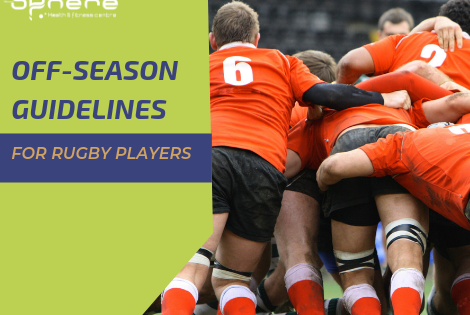Hi there John from Sphere Fitness and Rugby Academy and today I am going to give you some information with regards to your off-season for rugby fitness.
Okay if you are a rugby player and just finished your play season then listen up because what I’m going do is I’m going share with you today some great tips for mapping out your off season, which could last anywhere 12, 16, 20 weeks.
It really depends on when you want to kick off and get going. I know some lads who started you know a week before kicking off the championship, but anyway I digress.
It’s all about preparation so if you fail to prepare for rugby, you prepare to fail and really this is, you get out what you put into your pre-season. It’s a great period of time when you can just focus on your weaknesses and rather than keep honing your strengths all the time.
You really kind of be honest and focus where those weaknesses are and go after them big time.
So I’m going share with you a little step by step guide today on what a successful off season looks like and it needs from your needs analysis testing, injury prevention and call it now days.
Strength, speed strength, some accessory work, the right type of fitness you need to do and what we call that power endurance. We’re going to touch on health performance and then we’re going to work on kind of just combining this into a plan.
Player Audit
So the first protocol really is where we sit you down and we have a look at where you score yourself in all those realms of athletic profiles.
That can be strength, speeds, skill, endurance, flexibility, injury, red zones and so forth in rugby.
It really needs to be put into a melting pot and a score sheet and then you can see because everyone has individual weaknesses and you won’t know that until you take a good honest look at yourself and after a third party appraises where you’re at and on where you sit.
It’s all well and good. The easiest thing to do is what 99% of the players do is they just focus on their strengths so if they’re strong, they just keep getting stronger.
You know a time and a place, but really the off season is the time when you work really hard on your weaknesses (as outlined here) And then it comes to testing.
Most amateurs don’t have the time to train twice a day, 6 days a week. So this is where a good honest look at where your weaknesses are and go after 2-3 in the course of a 12-16 week period.
Your week may look like this (take this in some context please – when you are putting this together it could be 1 phase alone) : –
Monday Evening – All Over Body Weights
Tuesday – Stretching and Mobility Work (yep static stretching)
Weds Evening – All Over Body Weight 2
Thursday – Regeneration Stuff – Trip to the Pool
Friday – All Over Weights 3
Saturday – Maximal Aerobic Speed Work or Combat Conditioning
Sunday – OFF – Stretch
Testing
I’m all for accurate testing, but ultimately your testing comes in the gym and on the track or wherever you do it in terms of for your performances. It’s good to have some testing in a battery of tests that work.
It could be a 1RM in the big lifts such as the squat, Deadlift, Chin Up or Bench Press. Or a timed set of 3 reps, or a test that looks at your agility and so forth. If you have access to force plates then great.
Tests have to be relevant though.
In rugby you can also use the rep calculator of load x reps x 0.033 + load = estimate 1rm. I find anything over 5 reps for this gets inaccurate.
You know, things that test your strength, things that test your power levels, to test your you know your aerobic condition and primarily they act as a motivating tool.
Say for instance you come here for a body composition test and then in the end you are the same scale weight. But all that work has gone in and you’ve put on 4-5 pounds in muscle and you’ve lost the same amount of body fat. Ultimately you’re just a better specimen of an athlete so it’s really important that you focus on that area.
Injury Prevention for Rugby
Then we’ve got injury prevention and again from your needs and from your audit, you will see where those red zones lay on you so that could be a recurring hamstring pull.
It could be a recurring groin pull or tears, it could be knees or ankles you keep going over and so forth, but they all depend on you.
It could be your position as well, so your problem will ultimately have a different program design strategy and exercise selection compared to traditional strength programme.
So all these things have to be taken into account when you’re designing your program.
Rugby players for example should ALL be doing some form of neck work every session. Neck harness, 4 way neck work, isometrics, neck bridges on a swiss ball.
The foundation is ultimately laid with maximum strength work and again when you’re doing your injury prevention with stretching, it’s key that you learn to isolate, then integrate and we found it to be very, very important when if you’re rehabbing back from injuries that you’re really trying to prevent injuries.
I would do this stuff outside of the weight room though or during your rest intervals.
Focus on those areas and bring them up to speed because ultimately you’re only as strong as your weakest link.
Strength Work for Rugby
Once you’ve corrected that, which doesn’t take a lot of work, but it does take focused work, then you can really hone in on improving those maximum strength lifts and getting some good quality strength work.
If strength is already one of your strengths but you are slow, that’s when you can again focus on maybe lighter loads, but with faster velocities and you can get stronger that way as well.
In the off season, accessory exercises work so a lot of people make the mistake of just primarily focusing all their gym work around just accessory work. They miss the big bang exercises. They end up looking like body building routines.
This largely depends on what level you are starting at. Novices start with the big rocks and get lifting and progressing in a simple squat, bench and deadlift type programme with maybe some cleans. With a more advanced lifter we can then add in more variety to ensure more stimulus.
Sample Novice Strength Workout – All Over Body with Max Strength Focus
A) Safety Bar Back Squat 10 x 3 (work up to 3 RM – sets 8,9,10 should be over 90% going to ‘technical failure’ i.e. before the form gets messy.
B) Back Squat 3- 5 x 3-5 reps on a 4010 tempo. See how you are going and let your bar speed determine doing either 3 or 5 reps. Load is not that important – HOW you lift is.
C) Deadlift 1 x 5 (work up to this with 3-4 warm up sets)
We could also be pulling sleds, we could be working on individual body weight stuff to get more control around the joints.
We could be working on lower back or hamstrings or glute work.
We could be working on back work, upper back.
It could be anywhere where we have found a weakness in your chain which needs an extra bit of attention, so ultimately the whole unit comes up to speed with it because like I said, you’re only as strong as your weakest link, which leads us on to fitness.
Conditioning for Rugby
Rugby is played on your feet so ignore running at your peril and uses all 3 energy systems too – aerobic, anaerobic-lactic and anaerobic-alactic.
Now traditionally fitness is all about doing the laps or 10-15 minute jogs, 20 minute jogs, half an hour etc as part of something with purpose (warm up), tempo running for recovery. I think this is good for aerobic development but should be done WELL BEFORE PRE-SEASON.
Your time is better spent when you actually look at the demands of rugby come pre-season and it’s a power event. It’s short explosive bouts of work done repetitively for 80 minutes. This would lend itself to an anaerobic-alactic emphasis.
As Ian King writes ‘you can’t endure what you don’t have’. I love this. If you train slow, be slow. What about build a better more explosive energy then try and build the capacity to repeat output that!
So that’s how we condition our athletes, with power endurance and I love what I picked up from liked of Craig White.
Wrestling and grappling drills that we do a lot of and put them into sort of a skilled base expression circuit mixed with power and heavy weights done for low reps and so forth and so power endurance.
That’s the way to condition for rugby and get you actually fit for the game rather than things that don’t have any bearing or any relevancy to conditioning levels.
Dr. Dan Baker also widely used MAS circuits with rowing and running which I have also found to improve conditioning levels. But again, I would rather someone work on their basic running speed and trying to build the ability to repeat this time and time again!
Sample Conditioning Circuit – Advanced
A1) Cable Wrestle 3 reps each side (grind out each rep)
A2) Back Squat from High Pins x 3 – 75% of 1RM
A3) Partner Pick Up and Carry 5m x 3 each
A4) Get Ups with 15kg plate x 5
A5) Pummel Partner Full On x 15 seconds
Repeat x 3-5 circuits – use a HR monitor if available. Keep it above 85% of MHR.
Speed and Power for Rugby
Then we actually look at speed and power. Power and being able to express strength with high velocities in minimal time you know for things like jumping. As long as you have good level of foundational strength and then if you are strong, we can really hone in on the speed, which does require some sort of technique and looking at your mechanics to an extent but again that can be addressed as well.
You have to look at all 3 components of speed – acceleration, linear AND change of direction.
Speed training for forwards is a complete waste of time. Backs who are strong as hell particularly with good relative scores in squat and deadlifts would be best served with speed work.
(Where forwards can get more ‘speed’ is with running efficiency. If you can help with this then that can only be a good thing. This is something I will be working on in my group going forward. I haven’t found a forward who buys into this for any length of time to make it observable)
And this is where the magic really happens because you know we put together a great plan, 12-16 weeks in there, but your recovery, which essentially very, very under utilized.
You simply can’t break the body down and break it down greatly and we just keep training and training and training and we keep breaking the body down.
Recovery from Rugby Training
If the time outside of those windows where you’re breaking the body down is not very anabolic in a sense where it’s not helping or assisting your recovery, then you’re ultimately spinning your wheels and that’s where health comes in. Pool, massage, stretching, multi vitamins, fish oil, anabolics (kidding)
You do need to pay attention to diet and nutrition. You do need to monitor diet and sleep patterns and you just need to make a concerted effort to make the other 23 hours or 22 hours or however many other hours outside of the training count and that’s key.
So you know I credit Phil Richards for turning me on to this.
You need health for performance. There’s no two ways about it you know and it’s great when you see young athletes who can get away with a little bit more. But in the long run, you know they’re not going to keep and can they get away with it a little bit more.
I see correlations between athletes who insist on abusing their bodies with late nights and poor diets and yet still come into the gym. They break down, they pick up knocks, they pick up colds thinking they are unbreakable. Flus they just can’t shake. They do correlate. I don’t need studies to prove it. I can tell you now from the hundreds of athletes I’ve worked with over the years, health makes magic and then we look at the plan executed with conviction.
Intent
Now I can get twin A and twin B and I can get a fanciful plan executed with about as much enthusiasm as you know a toddler who wants to give up his toys. I get twin B with a plan that’s a bit loose but when they do it, they do it with 110%.
You know, I know who is going to be on the go when they go to play well prepared. (I have to credit Pieter Morton, one of my former athletes who is now playing in top tier French rugby for showing me what intent is).
It is the same with strength. I have seen some bears in the gym who are just that bears in the gym. Yet weak on the pitch. There are many reasons for this. But in most cases they just don’t have that ‘bite’ which I would carry with me over any athlete who can post impressive numbers.
You know so what I just laid out before you is important no doubt about it, but it’s got to be executed with conviction. So if you can’t commit to a certain amount of time even though it’s ideal and you can’t execute in reality of what is asked of you, then you’re wasting your time.
Concluding remarks
You’re better off making sure that you can actually commit to it with 100% and then follow it through rather than subbing which looks great on paper, but you’re not able to execute. So plan with conviction wins out at the end of the day. So there’s a few key pointers. You know we look to needs in our system, we look to testing injury prevention, strength, speed, etc. and ultimately the whole package, the whole piece of the pie has to be put together in some form.








